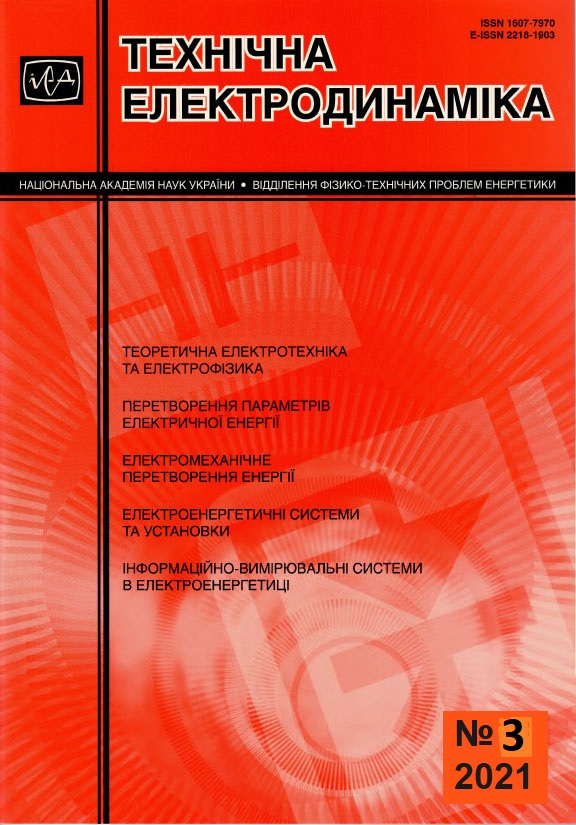Abstract
The energy efficiency of a pulsed barrier discharge in air was investigated when it treated a model water sample in a drop-film state containing an organic dye (methylene blue) with an initial concentration of 50 mg/l. The water consumption was 4 l/min, the characteristic droplet diameter was ~1 mm. Water treatment was carried out in a coaxial discharge chamber with a gas gap of 3.2 mm and additionally in an ozonation chamber. The discharge was generated by short ~ 100 ns voltage pulses of ≈26 kV, which provided a current density with an amplitude of ≈ 1.3 A/cm2 and a pulse energy of ≈ 140 mJ. The time of decomposition of the impurity and the energy efficiency of the discharge were investigated as a function of the pulse repetition rate of 25−300 Hz. The discharge had the highest energy efficiency at frequencies of 25-50 Hz, at which the energy yield corresponding to 50% decomposition of the impurity is about 100 g/kW h. It is shown that most of ozone, one of the main oxidants generated by the discharge, dissolves in water in the discharge chamber. The concentration of ozone at the outlet from the discharge chamber can reach 2.2 mg/l. The remaining ozone is absorbed by the model solution (about 60%) in the ozonization chamber. References 16, figures 7.
References
Vanraes P., Nikiforov A.Y., Leys Ch. Electrical Discharge in Water Treatment Technology for Micropollutant. Plasma Science and Technology - Progress in Physical States and Chemical Reactions. Chapter 15. 2016. Pp. 429−476. DOI: https://doi.org/10.5772/61830.
Muhammad Arif Malik. Water Purification by Plasmas: Which Reactors are Most Energy Efficient? Plasma Chemical Plasma Process. 2010. No 30. Pp. 21−31. DOI: https://doi.org/10.1007/s11090-009-9202-2 .
Bo Jiang, Jingtang Zheng, Shi Qiu, Qinhui Zhang, Zifeng Yan, Qingzhong Xue. Review on electrical discharge plasma technology for wastewater. Chemical Engineering Journal. 2014. No 236. Pp. 348–363. DOI: https://doi.org/10.1016/j.cej.2013.09.090
Magureanu M., Piroi D., Mandache N.B., Parvulescu V. Decomposition of methylene blue in water using a dielectric barrier discharge: Optimization of the operating parameters. Journal of Applied Physics. 2008. No 104. Pp. 103306-1–103306-7. DOI: https://doi.org/10.1063/1.3021452
Biljana P. Dojchinovich, Goran M. Roglicb, Bratislav M. Obradovich, Milorad M. Kuraicaca, Mirjana M. Kostich, Jelena Nesich, Dragan D. Manojlovich. Decolorization of reactive textile dyes using water falling film dielectric barrier discharge. Journal of Hazardous Materials. 2011. No 192. Pp. 763–771. DOI: https://doi.org/10.1016/j.jhazmat.2011.05.086
Bozhko I.V., Kondratenko I.P. Efficience of treatment of aqueous solution of methylene blue via exposure to pulse dielectric barrier dischargeto the surface. Tekhnichna Elektrodynamìka. 2018. No 6. Pp. 89–97. (Ukr) DOI: https://doi.org/10.15407/techned2018.06.089
Pokryvailo A., Wolf M., Yankelevich Y., Wald S., Grabowski L.R., Van Veldhuizen E.V.M., Rutgers W.R., Reiser M., Glock B., Eckhardt T., Kempenaers P., Welleman A. High-power pulsed corona for treatment of pollutants in heterogeneous media. IEEE transactions on plasma science. 2006. Vol. 34. No 5. Pp. 1731–1743. DOI: https://doi.org/10.1109/TPS.2006.881281
Taichi Sugai, Yasushi Minamitani. Influence of Rise Rate of Applied Voltage for Water Treatment by Pulsed Streamer Discharge in Air-Sprayed Droplets. IEEE Transactions on Plasma Science. 2013. Vol. 41. Iss. 8. Pp. 2327–2334. DOI: https://doi.org/10.1109/TPS.2013.2271319
Taichi Sugai, Akira Tokuchi, Weihua Jiang. Effects of Pulsed Power Control on Plasma Water Treatment Using LTD. IEEE Transactions on Plasma Science. 2018. Vol. 46. Issue 10. Pp. 3566−3573. DOI: https://doo.org/10.1109/TPS.2018.2825468
Song Jiang, Yiyong Wen, Kefu Liu. Investigation of Pulsed Dielectric Barrier Discharge System on Water Treatment by Liquid Droplets in Air. IEEE Transactions on Dielectrics and Electrical Insulation. 2015. Vol. 22. No 4. Pp. 1866−1871. DOI: https:doi.org/10.1109/TDEI.2015.7179142
Yavorovskiy N.A., Kornev Ya.I., Preis S.V., Pelchtsman S.S., Haskelberg M.B., Chen B.N. Active oxidizing particles in water-air flow. Bulleten Tomskoho Politekhnicheskoho Instituta. 2006. Vol. 309. No 2. Pp. 108–113 (Rus).
Walsh J.L., Konga M.G. 10 ns pulsed atmospheric air plasma for uniform treatment of polymeric surfaces. Applied Physics Letters. 2007. Vol. 91. P. 251504. DOI: https://doi.org/https://doi.org/10.1063/1.2825576
Bozhko I.V., Serdyuk Y.V. Determination of Energy of a Pulsed Dielectric Barrier Discharge and Method for Increasing Its Efficiency. IEEE Transactions on Plasma Science. 2017. Vol. 45. Iss. 12. Pp. 3064–3069. DOI: https://doi.org/10.1109/TPS.2017.2760888
Bozhko I.V., Bereka V.O. Uniform of pulse barrier discharge in the air of atmospheric pressure in the presence of water in a drop-film condition. Tekhnichna Elektrodynamìka. 2019. No 5. Pp. 17–21 (Ukr). DOI: https://doi.org/10.15407/techned2019.05.017
Fangmin Huang, Li Chen, HonglinWang, Zongcheng Yan. Analysis of the degradation mechanism of methylene blue by atmospheric pressure dielectric barrier discharge plasma. Chemical Engineering Journal. 2010. Vol. 162. Pp. 250–256. DOI: https://doi.org/10.1016/j.cej.2010.05.041
Bozhko I.V., Karlov A.N., Kondratenko I.P., Charnyj D.V. Development of complex for water treatment with pulse barrier discharge. Tekhnichna Elektrodynamìka. 2017. No 6. Pp. 80–86. (Ukr.) DOI: https://doi.org/10.15407/techned2017.06.080

This work is licensed under a Creative Commons Attribution-NonCommercial-NoDerivatives 4.0 International License.
Copyright (c) 2021 Tekhnichna Elektrodynamika


